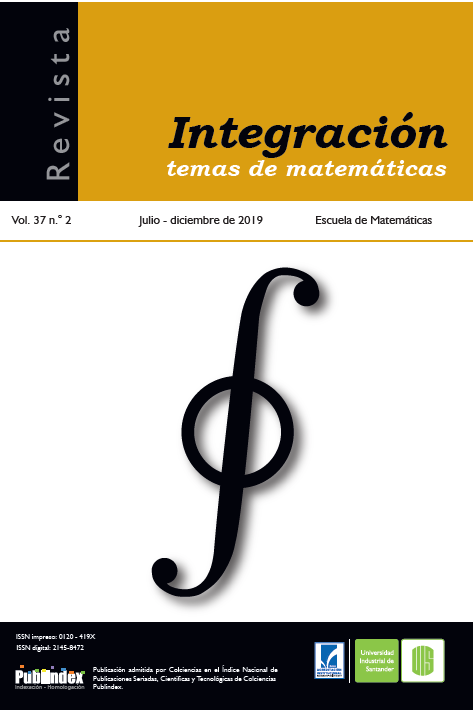Análisis asintótico de un sistema Darcy-Stokes acoplado a través de una interfaz curva
Publicado 2019-07-29
Palabras clave
- medio poroso,
- interfaces curvas,
- sistema Darcy-Stokes,
- sistema Darcy-Brinkman
Cómo citar
Resumen
En el trabajo se presenta el análisis asintótico de un sistema
Darcy-Stokes acoplado a través de una interfaz curva. El sistema modela el intercambio de fluido entre un canal angosto (flujo Stokes) y un medio poroso (flujo Darcy). El canal es un dominio cilíndrico definido entre la interfaz (Τ) y una traslación paralela de dicha superficie (Τ + ε eN, ε > 0). Utilizando un cambio de variables para fijar un dominio de referencia e introduciendo dos sistemas de coordenadas, el Cartesiano canónico y el local (consistente con la geometría de la superficie), es posible encontrar la forma límite cuando el ancho del canal tiende a cero (ε→ 0). El problema límite es un sistema
acoplado con flujo Darcy en el medio poroso y flujo Brinkman en la interfaz (Τ).
Descargas
Referencias
[2] Allaire G., Briane M., Brizzi R. and Capdeboscq Y., “Two asymptotic models for arrays of underground waste containers”, Applied Analysis 88 (2009), No. 10-11, 1445–1467.
[3] Arbogast T. and Brunson D.S., “A computational method for approximating a Darcy-Stokes system governing a vuggy porous medium”, Computational Geosciences 11 (2007), No. 3, 207–218. https://doi.org/10.1007/s10596-007-9043-0
[4] Arbogast T. and Lehr H., “Homogenization of a Darcy-Stokes system modeling vuggy porous media”, Computational Geosciences 10 (2006), No. 3, 291–302.
[5] Babuska I. and Gatica G.N., “A residual-based a posteriori error estimator for the Stokes-Darcy coupled problem”, SIAM J. Numer. Anal. 48 (2010), No. 2, 498–523.
[6] Cannon J.R. and Meyer G.H., “Diffusion in a fractured medium”, SIAM J. Appl. Math. 20 (1971), No. 3, 434–448.
[7] Dobberschütz S., “Stokes-Darcy coupling for periodically curved interfaces”, Comptes Rendus Mécanique 342 (2014), No. 2, 73–78.
[8] Dobberschütz S., “Effective behavior of a free fluid in contact with a flow in a curved porous medium”, SIAM J. Appl. Math. 75 (2015), No. 3, 953–977.
[9] Gatica G.N., Meddahi S. and Oyarzúa R., “A conforming mixed finite-element method for the coupling of fluid flow with porous media flow”, IMA J. Numer. Anal. 29 (2009), No. 1, 86–108.
[10] Girault V. and Raviart P.A., Finite element approximation of the Navier-Stokes equations, volume 749 of Lecture Notes in Mathematics. Springer-Verlag, Berlin, 1979.
[11] Lamichhane B.P., “A new finite element method for Darcy-Stokes-Brinkman equations”, ISRN Computational Mathematics 2013, 4 pages. http://dx.doi.org/10.1155/2013/798059
[12] Lesinigo M., D’Angelo C. and Quarteroni A., “A multiscale Darcy-Brinkman model for fluid flow in fractured porous media”, Numer. Math. 117 (2011), No. 4, 717–752.
[13] Martin V., Jaffré J. and Roberts J.E., “Modeling fractures and barriers as interfaces for flow in porous media”, SIAM J. Sci. Comput. 26 (2005), No. 5, 1667–1691.
[14] Morales F. and Showalter R.E., “A Darcy-Brinkman model of fractures in porous media”, J. Math. Anal. Appl. 452 (2017), No. 2, 1332–1358.
[15] Morales F.A., “The formal asymptotic expansion of a Darcy-Stokes coupled system”, Rev. Fac. Cienc. 2 (2013), No. 2, 9–24.
[16] Morales F.A., “Homogenization of geological fissured systems with curved non-periodic cracks”, Electronic Journal of Differential Equations 2014 (2014), No. 189, 1–21.
[17] Neuss–Radu M., “A result on the decay of the boundary layer in the homogenization theory”, Asymptot. Anal. 23 (2000), No. 3-4, 313–328.
[18] Neuss–Radu M., “The boundary behavior of a composite material”, Math. Model. Numer. Anal. 35 (2001), No. 3, 407–435.
[19] Tartar L., An introduction to Sobolev spaces and interpolation spaces, volume 3 of Lecture Notes of the Unione Matematica Italiana, Springer-Verlag, New York, 2007.
[20] Temam R., Navier-Stokes equations, volume 2 of Studies in Mathematics and its Applications, North-Holland Publishing Co., Amsterdam, 1979.
[21] Xie X., Xu J. and Xue G., “Uniformly-stable finite element methods for Darcy-Stokes- Brinkman models”, J. Comput. Math. 26 (2008), No. 3, 437–455.
